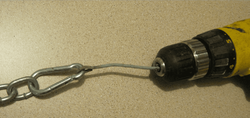I'm thinking about dropping some chains down the tubes in my older EKO 40, as others have. I think this "dog leg" hook will be a good way to rattle the chains to clean them and the inside of the fire tubes. The carabiner will allow me to move from chain to chain.
hr
hr


